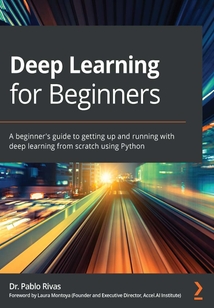舉報 

會員
Deep Learning for Beginners
Withinformationonthewebexponentiallyincreasing,ithasbecomemoredifficultthanevertonavigatethrougheverythingtofindreliablecontentthatwillhelpyougetstartedwithdeeplearning.Thisbookisdesignedtohelpyouifyou’reabeginnerlookingtoworkondeeplearningandbuilddeeplearningmodelsfromscratch,andalreadyhavethebasicmathematicalandprogrammingknowledgerequiredtogetstarted.Thebookbeginswithabasicoverviewofmachinelearning,guidingyouthroughsettinguppopularPythonframeworks.Youwillalsounderstandhowtopreparedatabycleaningandpreprocessingitfordeeplearning,andgraduallygoontoexploreneuralnetworks.Adedicatedsectionwillgiveyouinsightsintotheworkingofneuralnetworksbyhelpingyougethands-onwithtrainingsingleandmultiplelayersofneurons.Later,youwillcoverpopularneuralnetworkarchitecturessuchasCNNs,RNNs,AEs,VAEs,andGANswiththehelpofsimpleexamples,andyouwillevenbuildmodelsfromscratch.Attheendofeachchapter,youwillfindaquestionandanswersectiontohelpyoutestwhatyou’velearnedthroughthecourseofthebook.Bytheendofthisbook,you’llbewell-versedwithdeeplearningconceptsandhavetheknowledgeyouneedtousespecificalgorithmswithvarioustoolsfordifferenttasks.
目錄(141章)
倒序
- 封面
- 版權信息
- About Packt
- Why subscribe?
- Foreword
- Contributors
- About the author
- About the reviewers
- Packt is searching for authors like you
- Preface
- Who this book is for
- What this book covers
- To get the most out of this book
- Get in touch
- Section 1: Getting Up to Speed
- Introduction to Machine Learning
- Diving into the ML ecosystem
- Training ML algorithms from data
- Introducing deep learning
- Why is deep learning important today?
- Summary
- Questions and answers
- References
- Setup and Introduction to Deep Learning Frameworks
- Introduction to Colaboratory
- Introduction and setup of TensorFlow
- Introduction and setup of Keras
- Introduction to PyTorch
- Introduction to Dopamine
- Other deep learning libraries
- Summary
- Questions and answers
- References
- Preparing Data
- Binary data and binary classification
- Categorical data and multiple classes
- Real-valued data and univariate regression
- Altering the distribution of data
- Data augmentation
- Data dimensionality reduction
- Ethical implications of manipulating data
- Summary
- Questions and answers
- References
- Learning from Data
- Learning for a purpose
- Measuring success and error
- Identifying overfitting and generalization
- The art behind learning
- Ethical implications of training deep learning algorithms
- Summary
- Questions and answers
- References
- Training a Single Neuron
- The perceptron model
- The perceptron learning algorithm
- A perceptron over non-linearly separable data
- Summary
- Questions and answers
- References
- Training Multiple Layers of Neurons
- The MLP model
- Minimizing the error
- Finding the best hyperparameters
- Summary
- Questions and answers
- References
- Section 2: Unsupervised Deep Learning
- Autoencoders
- Introduction to unsupervised learning
- Encoding and decoding layers
- Applications in dimensionality reduction and visualization
- Ethical implications of unsupervised learning
- Summary
- Questions and answers
- References
- Deep Autoencoders
- Introducing deep belief networks
- Making deep autoencoders
- Exploring latent spaces with deep autoencoders
- Summary
- Questions and answers
- References
- Variational Autoencoders
- Introducing deep generative models
- Examining the VAE model
- Comparing a deep and shallow VAE on MNIST
- Thinking about the ethical implications of generative models
- Summary
- Questions and answers
- References
- Restricted Boltzmann Machines
- Introduction to RBMs
- Learning data representations with RBMs
- Comparing RBMs and AEs
- Summary
- Questions and answers
- References
- Section 3: Supervised Deep Learning
- Deep and Wide Neural Networks
- Wide neural networks
- Dense deep neural networks
- Sparse deep neural networks
- Hyperparameter optimization
- Summary
- Questions and answers
- References
- Convolutional Neural Networks
- Introduction to convolutional neural networks
- Convolution in n-dimensions
- Convolutional layers
- Pooling strategies
- Convolutional neural network for CIFAR-10
- Summary
- Questions and answers
- References
- Recurrent Neural Networks
- Introduction to recurrent neural networks
- Long short-term memory models
- Sequence-to-vector models
- Vector-to-sequence models
- Sequence-to-sequence models
- Ethical implications
- Summary
- Questions and answers
- References
- Generative Adversarial Networks
- Introducing adversarial learning
- Training a GAN
- Comparing GANs and VAEs
- Thinking about the ethical implications of GANs
- Summary
- Questions and answers
- References
- Final Remarks on the Future of Deep Learning
- Looking for advanced topics in deep learning
- Learning with more resources from Packt
- Summary
- References
- Other Books You May Enjoy
- Leave a review - let other readers know what you think 更新時間:2021-06-11 18:20:47
推薦閱讀
- Instant uTorrent
- Effective STL中文版:50條有效使用STL的經驗(雙色)
- The Applied AI and Natural Language Processing Workshop
- Getting Started with Qt 5
- 計算機維修與維護技術速成
- 固態存儲:原理、架構與數據安全
- 筆記本電腦維修實踐教程
- 龍芯自主可信計算及應用
- Hands-On Artificial Intelligence for Banking
- Intel Edison智能硬件開發指南:基于Yocto Project
- 基于PROTEUS的電路設計、仿真與制板
- 計算機電路基礎(第2版)
- Instant Website Touch Integration
- 微型計算機原理及應用教程(第2版)
- INSTANT Cinema 4D Starter
- CPU設計實戰:LoongArch版
- 電腦組裝與硬件維修從入門到精通
- Hands-On Unsupervised Learning with Python
- Mastering JavaServer Faces 2.2
- OpenCV 4 Computer Vision Application Programming Cookbook(Fourth Edition)
- 三菱FX2N系列PLC入門與應用實例
- Arduino項目開發:物聯網應用
- Deep Learning for Beginners
- 圖解芯片技術
- Hands-On Natural Language Processing with PyTorch 1.x
- 電腦組裝與維修從入門到精通
- Final Cut Pro X Cookbook
- Machine Learning for Finance
- 24小時學會電腦維護與故障處理
- 設計模式就該這樣學:基于經典框架源碼和真實業務場景

